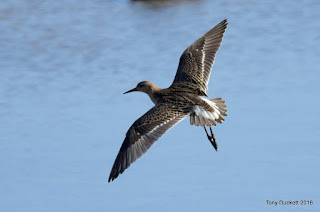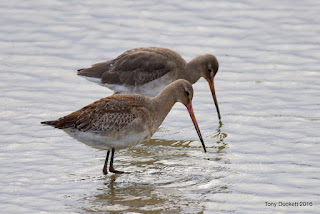Norfolk 24th September - 2nd October
The weather the weekend before our trip had been ideal and many fall migrants were scattered along much of the Norfolk Coast. Luck unfortunately wasn't on our side and the wind had swung around to the SW, totally the wrong direction. This meant that most of the sheltered spots migrants from the east like to shelter in were buffeted by brisk winds, making finding any birds that may have stayed from the previous weekend difficult. We did our best finding the odd goody or going to look at 1 or 2 that others had found. In total I did manage 130 species but it could easily been 140+ if the winds were more favourable.
Below are my photographic highs.
I have been extremely luck recently, managing some decent photos of Whinchat's in the park
and now in Norfolk. This bird was at the end of Garden Drove, which is where I normally
visit to see raptors in the winter month's.
There were a few Goldcrest's in the Dell at Wells' Wood but it took some doing
trying to find this Yellow-browed Warbler. It looked great through bins but trying to
get a photo was really difficult due to the gusty conditions.
Curlew Sandpiper's are a really elegant wader and even when the Dunlin's with the
extra long bills are on the scene they don't quite carry it off though some may people
may be fooled.
A female Ruff (Reeve) flies in and shows a faint pectoral band, though it is not as
prominent as the Pectoral Sandpiper, who's views we had on this day were limited as
it fed in tall vegetation.
On the Sunday we traipsed around Winterton Dunes in the hope of finding something
of interest. I was just about to say let's turn back when we saw a warbler with a grey back
disappear into a small bush. It was a fair way off, so we waited then out popped this Barred
Warbler, it showed well for a few seconds before flying off beyond a fence and into cover on
the edge of a copse. We waited a while but it didn't reappear so we left it, after putting the
news out. It was relocated and remained for several days, being joined by a Red-backed
Shrike later that first day.
As we were on the east coast we decided to explore the bushes behind the dunes at Waxham.
They have recently opened up new pathways as part of the Norfolk Coastal Path, so an area that had become overgrown in recent years is once again accessible. While looking and
listening for the hoped for Yellow-browed we at first heard and then observed the first skiens
of Pink-footed Geese arriving at their Broadland wintering grounds.
Sea watching was pretty grim for much of the stay not picking up until my last day, a day
when I had some decorating to finish. We had seen the odd Sooty and Balearic Shearwater,
Great Skua and Black-throated Diver. Gannet's and Red-throated were the commonest of
the more unusual species. On my last morning in a couple of hours in heavy showers and a
strong NE wind I saw 6 Sooty's and 8 Balearic's Shearwaters, 13 Great Skua's, 18 Arctic
Skua's, 180 Red-throated Divers and a steady stream of Gannets. The Sooty's were all singles
and fairly close inshore.
Red-throated Diver close inshore at Cley
Numbers of Brent Geese were very low.
European Wigeon were in good numbers as were Common Teal but I didn't see any
Pintail.
This 1st winter GBB Gull was left floundering when an older bird stole it.
Bearded Tits were very mobile at Titchwell on one of our visits.

Ruff
Dunlin
Spot the Curlew Sandpipers
Pied Wagtail and Little Stint
Black-tailed Godwit with Snipe photo bombing
Pectoral Sandpiper looking splendid
We decided not to go when this bird returned to Brancaster Golf Course after being absent
for several days. Once we saw the photos later that evening it was our first port of call the
following day.
Common Redshank
Ruff
Reeve
Waders and small passerines need to be on alert as there are 6 species of birds of prey that
are looking for an easy meal. This female Merlin and the Hobby and Peregrine are around
reserve daily.
Knot
Bar-tailed Godwit
Spotted Redshank (above) and Greenshank (below)
Black-tailed Godwit's above and below
Golden Plover (above) Grey Plover's (below)
The weather the weekend before our trip had been ideal and many fall migrants were scattered along much of the Norfolk Coast. Luck unfortunately wasn't on our side and the wind had swung around to the SW, totally the wrong direction. This meant that most of the sheltered spots migrants from the east like to shelter in were buffeted by brisk winds, making finding any birds that may have stayed from the previous weekend difficult. We did our best finding the odd goody or going to look at 1 or 2 that others had found. In total I did manage 130 species but it could easily been 140+ if the winds were more favourable.
Below are my photographic highs.
I have been extremely luck recently, managing some decent photos of Whinchat's in the park
and now in Norfolk. This bird was at the end of Garden Drove, which is where I normally
visit to see raptors in the winter month's.
There were a few Goldcrest's in the Dell at Wells' Wood but it took some doing
trying to find this Yellow-browed Warbler. It looked great through bins but trying to
get a photo was really difficult due to the gusty conditions.
Curlew Sandpiper's are a really elegant wader and even when the Dunlin's with the
extra long bills are on the scene they don't quite carry it off though some may people
may be fooled.
A female Ruff (Reeve) flies in and shows a faint pectoral band, though it is not as
prominent as the Pectoral Sandpiper, who's views we had on this day were limited as
it fed in tall vegetation.
On the Sunday we traipsed around Winterton Dunes in the hope of finding something
of interest. I was just about to say let's turn back when we saw a warbler with a grey back
disappear into a small bush. It was a fair way off, so we waited then out popped this Barred
Warbler, it showed well for a few seconds before flying off beyond a fence and into cover on
the edge of a copse. We waited a while but it didn't reappear so we left it, after putting the
news out. It was relocated and remained for several days, being joined by a Red-backed
Shrike later that first day.
As we were on the east coast we decided to explore the bushes behind the dunes at Waxham.
They have recently opened up new pathways as part of the Norfolk Coastal Path, so an area that had become overgrown in recent years is once again accessible. While looking and
listening for the hoped for Yellow-browed we at first heard and then observed the first skiens
of Pink-footed Geese arriving at their Broadland wintering grounds.
Sea watching was pretty grim for much of the stay not picking up until my last day, a day
when I had some decorating to finish. We had seen the odd Sooty and Balearic Shearwater,
Great Skua and Black-throated Diver. Gannet's and Red-throated were the commonest of
the more unusual species. On my last morning in a couple of hours in heavy showers and a
strong NE wind I saw 6 Sooty's and 8 Balearic's Shearwaters, 13 Great Skua's, 18 Arctic
Skua's, 180 Red-throated Divers and a steady stream of Gannets. The Sooty's were all singles
and fairly close inshore.
Red-throated Diver close inshore at Cley
Numbers of Brent Geese were very low.
European Wigeon were in good numbers as were Common Teal but I didn't see any
Pintail.
This 1st winter GBB Gull was left floundering when an older bird stole it.
Bearded Tits were very mobile at Titchwell on one of our visits.

Ruff
Dunlin
Spot the Curlew Sandpipers
Pied Wagtail and Little Stint
Black-tailed Godwit with Snipe photo bombing
Pectoral Sandpiper looking splendid
We decided not to go when this bird returned to Brancaster Golf Course after being absent
for several days. Once we saw the photos later that evening it was our first port of call the
following day.
Common Redshank
Ruff
Reeve
Waders and small passerines need to be on alert as there are 6 species of birds of prey that
are looking for an easy meal. This female Merlin and the Hobby and Peregrine are around
reserve daily.
Knot
Bar-tailed Godwit
Spotted Redshank (above) and Greenshank (below)
Black-tailed Godwit's above and below
Golden Plover (above) Grey Plover's (below)


















































































Comments